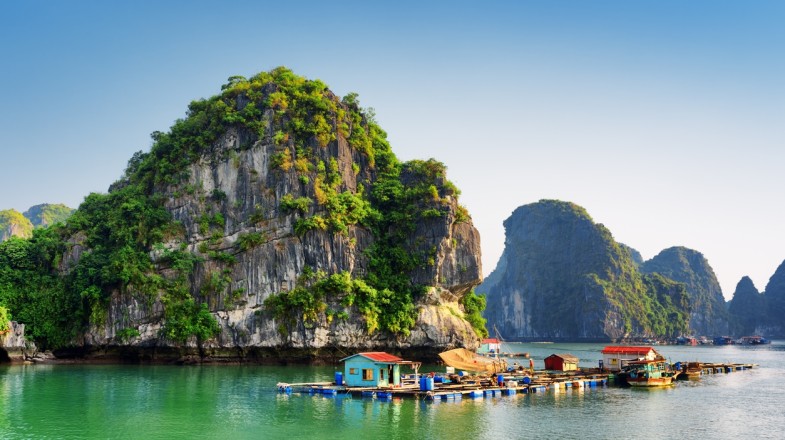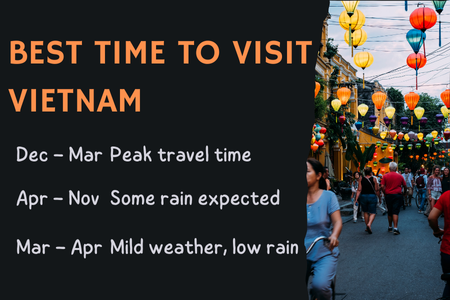Vietnam, with its mesmerizing landscapes, rich cultural heritage, and vibrant cities, has become a top destination for Indian travelers. However, the country’s diverse climate zones mean that the best time to visit Vietnam varies depending on the region and season. This guide helps Indian tourists navigate Vietnam’s weather patterns, ensuring a comfortable and unforgettable journey.
Decoding Vietnam’s Climate: A Seasonal Guide for Indian Travelers

Vietnam’s elongated geography results in distinct weather patterns across its northern, central, and southern regions. For Indian tourists, understanding these variations is key to planning a seamless trip.
Northern Vietnam: Four Seasons in One Destination
Northern Vietnam, home to Hanoi, Sapa, and Ha Long Bay, experiences four distinct seasons.
Winter (December-February) offers cool, dry weather—ideal for exploring Hanoi’s colonial architecture or trekking in Sapa’s misty mountains. However, temperatures can drop significantly, so packing warm clothing is essential.
Spring (March-May) brings blooming flowers and rising humidity, making it a scenic but slightly sticky time to visit. Summer (June-August) is hot and humid, while autumn (September-November) provides pleasant temperatures and golden landscapes.
Central Vietnam: Sun, Sand, and Occasional Storms
Central Vietnam, including Da Nang, Hoi An, and Hue, has a longer dry season (March-August), perfect for beach lovers.
The region’s rainy season (September-January) can bring typhoons, disrupting travel plans. Indian tourists should monitor weather forecasts if visiting during these months.
Southern Vietnam: Tropical Heat and Monsoon Rains
Southern Vietnam, encompassing Ho Chi Minh City and the Mekong Delta, has a tropical climate with two main seasons.
The dry season (December-April) is the best time to visit Vietnam for Indian travelers, offering sunny skies and comfortable humidity levels. The wet season (May-November) brings heavy rains but also lush green landscapes and fewer crowds.
Optimizing Your Trip: Identifying the Best Time to Visit Vietnam from India

Choosing the right season depends on your travel preferences—whether you seek adventure, relaxation, or cultural immersion.
Balancing Weather and Crowds for a Hassle-Free Experience
Peak tourist seasons (December-February and June-August) mean higher prices and crowded attractions. Shoulder seasons (March-May and September-November) offer a sweet spot—good weather with fewer tourists.
Indian travelers looking for budget-friendly options might prefer the wet season, but they should be prepared for occasional disruptions.
Festivals and Cultural Events: Timing Your Visit Right
Vietnam’s Tet Festival (Lunar New Year, usually in January or February) is a vibrant but busy time to visit. Hotels book up quickly, and prices surge.
For a quieter experience, consider visiting during the Mid-Autumn Festival (September) or the Hue Festival (biennial, April-May), which showcase Vietnam’s rich traditions without the overwhelming crowds.
Health and Comfort Considerations for Indian Tourists
High humidity and heat can be challenging for those unaccustomed to tropical climates. Staying hydrated, wearing breathable clothing, and scheduling outdoor activities for early mornings or late afternoons can help.
Northern Vietnam’s cooler winters may be more comfortable for travelers from North India, while those from South India might prefer the familiar warmth of the south.
Vietnam Through the Seasons: Tailoring Your Itinerary to the Climate

Each season in Vietnam offers unique experiences. Here’s how Indian tourists can make the most of their visit.
Winter Wonders: Exploring Northern Vietnam’s Cool Charms
Hanoi’s French-colonial architecture and street food scene shine in the crisp winter air. Sapa’s terraced rice fields, though chilly, provide breathtaking views.
Ha Long Bay cruises are magical during this time, though fog can occasionally obscure the scenery. Packing layers is essential for comfort.
Spring Adventures: Blossoms and Beach Escapes
Spring is perfect for exploring Central Vietnam’s beaches and ancient towns. Hoi An’s lantern-lit streets and Da Nang’s pristine shores are must-visits.
In the north, cherry blossoms and peach flowers add color to the landscape, making it a photographer’s paradise.
Summer Escapes: Navigating Heat and Rain
Southern Vietnam’s monsoon season can be unpredictable, but the Mekong Delta’s floating markets are still a fascinating experience.
Central Vietnam’s beaches remain a good option, though occasional storms may require flexibility in travel plans.
Beyond the Monsoon: Finding the Perfect Time for Indian Tourists to Experience Vietnam
Vietnam’s weather is just one factor in planning the perfect trip. Cultural events, local festivals, and personal preferences all play a role.
Off-the-Beaten-Path Destinations for Every Season
For those willing to venture beyond popular spots, destinations like Phong Nha-Ke Bang National Park (best visited in the dry season) or the highlands of Dalat (pleasant year-round) offer unique experiences.
Combining Vietnam with Neighboring Countries
Indian tourists often combine Vietnam with Cambodia or Thailand. Understanding regional weather patterns can help in planning a seamless multi-country itinerary.
Conclusion
The best time to visit Vietnam for Indian tourists depends on their preferred activities and tolerance for heat, rain, or cold. By aligning travel plans with Vietnam’s seasonal variations, travelers can enjoy a comfortable and enriching experience in this beautiful country. Whether it’s the cool winters of the north, the sunny beaches of the center, or the tropical warmth of the south, Vietnam has something to offer year-round.
`



